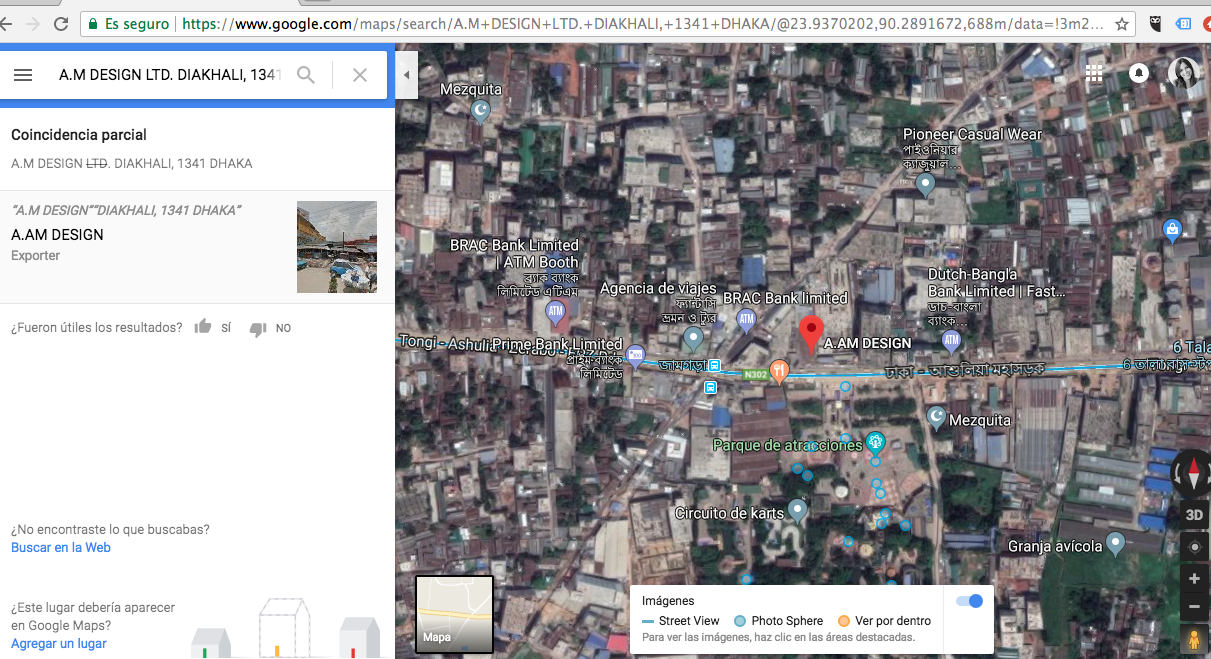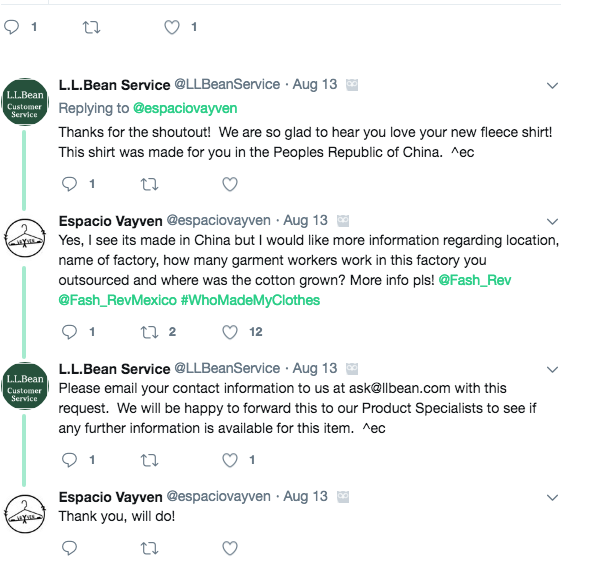
I´ve written about this garment before. It´s a plaid cotton shirt, with fleece lining. Components: shell 100% cotton, lining 100% polyester. Made in China, worn in #Cuernavaca. It was my aunt Butchie´s, and now it´s become my go-to house-wear, it´s even part of my first Fashion Revolution #LoveStory! My aunt lived in the Pacific North West, and I like to imagine this is exactly what she would wear if she were reading a book on the couch, or going to work early in the morning with freezing cold weather. I think I´ve seen her in these scenarios wearing it. The moment I tried it on I felt warmth and comfort. I was snuggled by its cozy fabric. It has plastic blue buttons and a pocket, where I usually save my Kleenexes when I wake up with an allergy to the morning. I don´t know if my aunt bought this secondhand or not, at times she would “spend more bucks” on a brand she liked, and I guess L.L. Bean was one of them.

I never paid attention to the label, until Trump tweeted “…Buy L.L. Bean @LBPerfectMaine” after announcing that Linda Bean (one of the 50 family owners), supported his #MAGA campaign. So of course, people boycotted and L.L. Bean issued a public statement on Facebook. Trump thought they would get more sales with his oh so powerful tweet. I´ve never purchased L.L. Bean and wouldn´t, since I decided 2 years ago to only buy secondhand or locally made, but because I love this garment, I´ve taken the task to investigate it´s origins, and question L.L. Bean´s management and if they´ve actually followed up on what they´ve said in the past.
In Fashion Revolution´s 2018 “Transparency Index” they are scoring between 0-10%, yet for some reason, ethical and sustainable blogs, post on how L.L. Bean is a sustainable, made in America and reputable brand, but the fact is that 75% of its products are imported, made in China, Bangladesh, Thailand, Malaysia, El Salvador, Vietnam and Sri Lanka, basically underdeveloped countries with high levels of corruption within its government and political instability. They usually get paid 30 cents an hour, work more than 10 hours, and have little to no worker rights. Some experience abuse, threats, child and forced labor, and the list could go on… But in this case, with L.L. Bean, we don´t know! We don´t know how much their garment workers get paid, we don´t know which factories oversees they employ, we don´t know how they work with those owners and it´s employees… basically how well involved they are with their supply chain.
Look at H&M for instance, they have a list of their suppliers, research those addresses on Google Maps and you´ll see the geographical/ architectural conditions in which our clothes are made. You´ll see guards at the entrance, cement walls, poor structures, and impoverished lands with spots of blue ponds made by the factory´s chemical and -I could only assume- hazardous artificial dyes.








-I have a lot of questions for H&M, but AT LEAST they are giving us information, and I can´t leave unrecognized their recycling campaign and Conscious Exclusive collection, yet their model is still unsustainable being fast-fashion with approximately 52 seasons a year.
WE NEED TO SLOW IT DOWN! and consumers can make brands change their model, by purchasing less. But as Elizabeth Cline explains, because of it´s fast-fashion nature, a small change in how they manage their supply chain can have huge impacts in the industry and because of their enormous marketing budgets, they hold most of the power on influencing consumers, addressing these issues in layman´s terms to anyone unaware of this crisis.
But, L.L. Bean where do you source your cotton? I´m still waiting for your e-mail response. In public you answered fast; my #whomademyclothes question on Twitter or when the International Labor Rights Forum added you on their “Sweatshop Hall of Shame” for not issuing a public statement saying you would oppose “the use of forced child labor in Uzbekistan´s cotton industry,” then you were fast to respond.
Side note: I don´t think you need to “eventually” exclude cotton from a country that mandates it´s children to harvest every fall. This action needs to be done immediately and under supervision. Even more so, when you say you have employees (even from your own headquarters in Freeport) in countries of production and work “with third-party monitors who ensure that there is no subcontracting.”

L.L. Bean, you signed up for the Fair Factories Clearinghouse, a database that has “social compliance information from thousand of factories,” (Harney, Alexandra. The China Price: the True Cost of Chinese Competitive Advantage. 2009) and in 2013, after the collapse of the Rana Plaza, in Dhaka, Bangladesh, were 1,139 garment workers tragically lost their lives due to negligence, greed and fast fashion, you said you would pay close attention to your supply chain, so you must have all the information on where you source your materials and employ your garment factories, right?
Was the cotton grown in China? Where there´s also cases of forced and child labor? 40,000 to 1 million children, as young as third graders, in the Xinjiang Uighur Autonomous Region and in Gansu province, are forced to pick daily cuotas of cotton during the autumn harvest. Having little to no pay, and their cotton harvesting performance assessed in order to determine if they´ll be fined or promoted to higher educational grade levels. Or is it Uzbek cotton?, the country you pledged to “eventually” keep out of your supply chain, and the second largest exporter of cotton after the United States. China is the number one producer of cotton, followed by India, where cotton farmers indebted with Monsanto and their GMO seeds, decide to end their lives out of desperation, or is it actually made in the United States? The third largest cotton producer.
Are you supporting modern day slavery? 
In 2015, Forbes listed L.L. Bean as #9 America´s Best Midsize Employers and #5 America´s Best Employers, with 5,000 employees and offers “health coverage…health and dependent care reimbursement accounts; 401 (k); tuition reimbursement; employee discounts; onsite fitness program… the Employee Store… the use of company vacation properties…” (Plunkett, Jack W. Plunkett’s Retail Industry Almanac 2009). But what about all the other people not accounted for? The person who grew the cotton, who made the polyester, who worked the machines, who put together the piece? The people actually responsible for making my “American” brand T-Shirt, what benefits do they have?
In the wake of the Rana Plaza, when L.L. Bean had the opportunity to prove that they were interested in safekeeping their garment workers lives, by signing on a union sponsored agreement, that was most importantly, legally binding, dedicated to use funds to “upgrade the infrastructure and safety equipment of factories throughout Bangladesh,” they shunned the deal in favor of a much weaker pact called the “Alliance for Bangladesh Worker Safety… which requires Bangladesh factories to fix problems themselves, (or pay back loan for repairs). If the factories don´t get up to code the Alliance´s retailers say they will simply cancel orders and cut ties” (Cline, E. Can Fast Fashion Clean up its act? 2013). So where´s your real change and interest for safeguarding and improving your workers lives?
Since you don´t give me an answer, I can only assume and ask that you, shopper and enthusiast of L.L. Bean; contact them and let them know you want transparency in their supply chain, you want to know the efforts they´ve made in improving worker conditions and environmental practices throughout their garment supply chain. Brands need to be more responsible and involved for how their garment workers are treated all around the globe, and effectively help them to improve their living conditions, not take advantage of them.
-My letter to L.L. Bean-

L.L. Bean, have a visible supply chain, have information ready to share, and while you´re at it use organic cotton. In reality the difference probably is only a couple of cents per garment, to make their garments in a safe and fair way. Make a change and step up your game, you´re supposed to be the “world´s most inclusive club”.
And you my dear friend ask #WhoMadeMyClothes and let´s have an interest in protecting worker rights, the people behind our clothes, by taking a stand, demanding transparency and revolutionizing the fashion industry at any level that we can.
Click here to read what´s changed in the fashion industry since Fashion Revolution began, and I would love to read your comments on the issue!
Jess C.